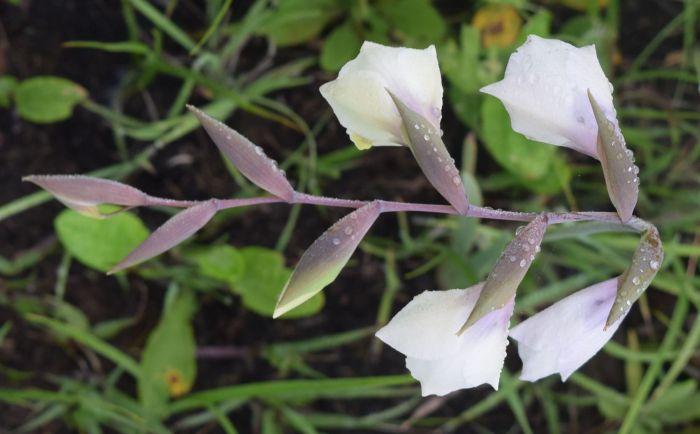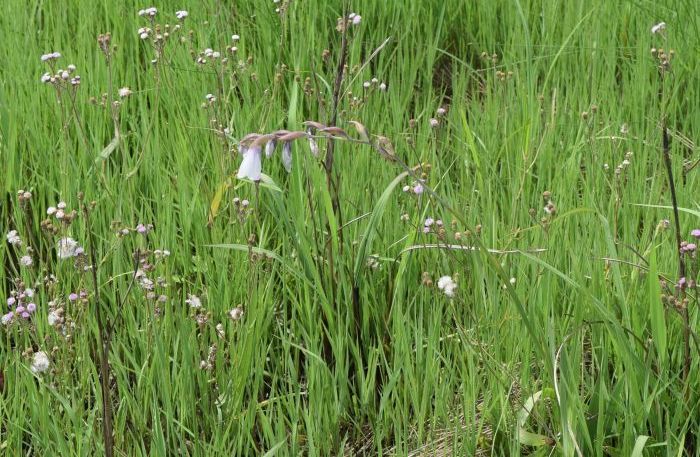Gladiolus papilio
Gladiolus papilio Hook.f.
Family: Iridaceae
Common names: butterfly gladiolus, goldblotch gladiolus (Eng.); ibutha, igulusha (Zul.).
Introduction
When exploring the wetlands of the eastern regions of South Africa, these pinkish mauve, nodding flowers are sure to capture your attention.

Description
Description
Gladiolus papilio is a deciduous, summer-growing, cormous geophyte, 500–750 mm in height. The corms are small and covered with brown tunics. The stems are erect and inclined after the uppermost leaf. The leaves are fan-like in appearance, the texture is firm and the veins are parallel. The leaves are sword-shaped and the midrib and margin are thickened, a characteristic of the genus. The shape of the leaf is lanceolate (tapering). A plant produces 6 or 7 leaves, but may produce up to 9 leaves, with a diameter of 9–14 mm. The lower leaves are the longest and they reach the middle of the stem, whereas the upper leaves are cauline (attached to the stem). Stems are slightly inclined. Cataphylls (scale like leaves) are leathery. Bracts are grey-green.

The inflorescence (the part of the plant that bears flowers) is a spike of 4 to 8 flowers, however, one can bear up to 13 flowers. The inflorescence is inclined towards the ground. The flowers are funnel- or bell-shaped, 18–20 mm long and are curved and drooping towards the ground. These nodding flowers make this species unique. The shape of the tepals is obovoid. In this species the flower colour is variable, flowers are often mauve or pinkish, sometimes creamy yellow or light green. A light purple or creamy green colour occurs on the inside of the upper tepals and a grey-purple colour occurs on the reverse. The inside of the lower lateral tepals have purple blotches with a yellow crescent. These patterns are nectar guides, which attract pollinators. Flowering time is from late spring through summer, from November to February. The fruit capsules are oblong and have 3 lobes, 18–24 mm in length. Seeds are winged and rust-brown.

Conservation Status
Status
Gladiolus papilio is assessed as Least Concern (LC) according to SANBI’s Red List of South African plants.
Distribution and habitat
Distribution description
It occurs in wetlands or marshes and is distributed in the eastern, summer-rainfall part of the country. It extends from the Eastern Cape to KwaZulu-Natal all the way through to Mpumalanga, as well as in the eastern half of the Free State, and in Lesotho and Eswatini (Swaziland). This plant has underground stolons and can be seen in dense colonies in the field, as a result of vegetative reproduction.

Derivation of name and historical aspects
History
The genus name Gladiolus is derived from the Latin word for ‘little sword’, the leaves are shaped like a sword. The species name papilio is Latin for ‘butterfly-like’, referring to the markings on the lower tepals that resemble the wings of a butterfly.
This plant was cultivated using corms as early as the 1860s at the Royal Botanic Gardens at Kew in Britain.

Ecology
Ecology
Gladiolus papilio is pollinated by bees, possibly the golden-haired Amegilla capensis, and the flowers do not produce any scent.

Uses
Use
Gladiolus papilio is important in horticulture and are sold as cut flowers; people also grow them in their gardens as an ornamental plant.

Growing Gladiolus papilio
Grow
Gladiolus papilio can be propagated from seeds. The flowers are predated by chafer beetles so they have to be bagged in order to protect them, and to allow the seeds to develop. Harvested seeds must immediately be treated with a powdered insecticide in order to safeguard them from further predation. Store the seeds for a short resting period in a cool, dry place (for example, in a brown paper packet) for at least 2 weeks. The best time of year to plant the seed is before the end of summer. Plant them in seedling compost. Young seedlings need to be kept moist in the warm growing months. Reduce the watering in winter, but not completely, while they are still very young. Feed the young plants with liquid fertilizer. Keep several plants crowded in a single pot because they grow better this way. As the plants grow, they can be transferred into slightly bigger pots, but no bigger than 200 mm wide. Best grown in full sun. Flowering can occur 3 to 4 years after seeds are planted. They make attractive pot plants.
References
- Foden, W. & Potter, L. 2005. Gladiolus papilio Hook.f. National Assessment: Red List of South African plants version 2020.1. Accessed on 2021/02/17.
- Goldblatt, P. 1996. Gladiolus in tropical Africa. Systematics, biology & evolution. Timber Press, Portland.
- Goldblatt, P. & Manning, J. 1998. Gladiolus in southern Africa. Fernwood Press, Vlaeberg.
- Lewis, G.J., Obermeyer, A.A. & Barnard, T.T. 1972. Gladiolus: a revision of the South African species. Journal of South African Botany Suppl. 10
- Pooley, E. 2003. Mountain flowers, a field guide to the flora of the Drakensberg and Lesotho. Natal Flora Publications Trust, Durban.
Credits
Simone Chetty
Custodians for Rare and Endangered Wildflowers - CREW KZN node
March 2021
Acknowledgements: the author thanks Alison Young and Kaveesha Naicker.
Plant Attributes:
Plant Type: Bulb
SA Distribution: Eastern Cape, Free State, Gauteng, KwaZulu-Natal, Limpopo, Mpumalanga, North West
Soil type: Sandy, Loam
Flowering season: Early Summer, Late Summer
PH:
Flower colour: Green, Purple, White, Pink, Cream, Yellow, Mauve/Lilac
Aspect: Full Sun
Gardening skill: Average
Special Features:
Horticultural zones









Rate this article
Article well written and informative
Rate this plant
Is this an interesting plant?
Login to add your Comment
Back to topNot registered yet? Click here to register.